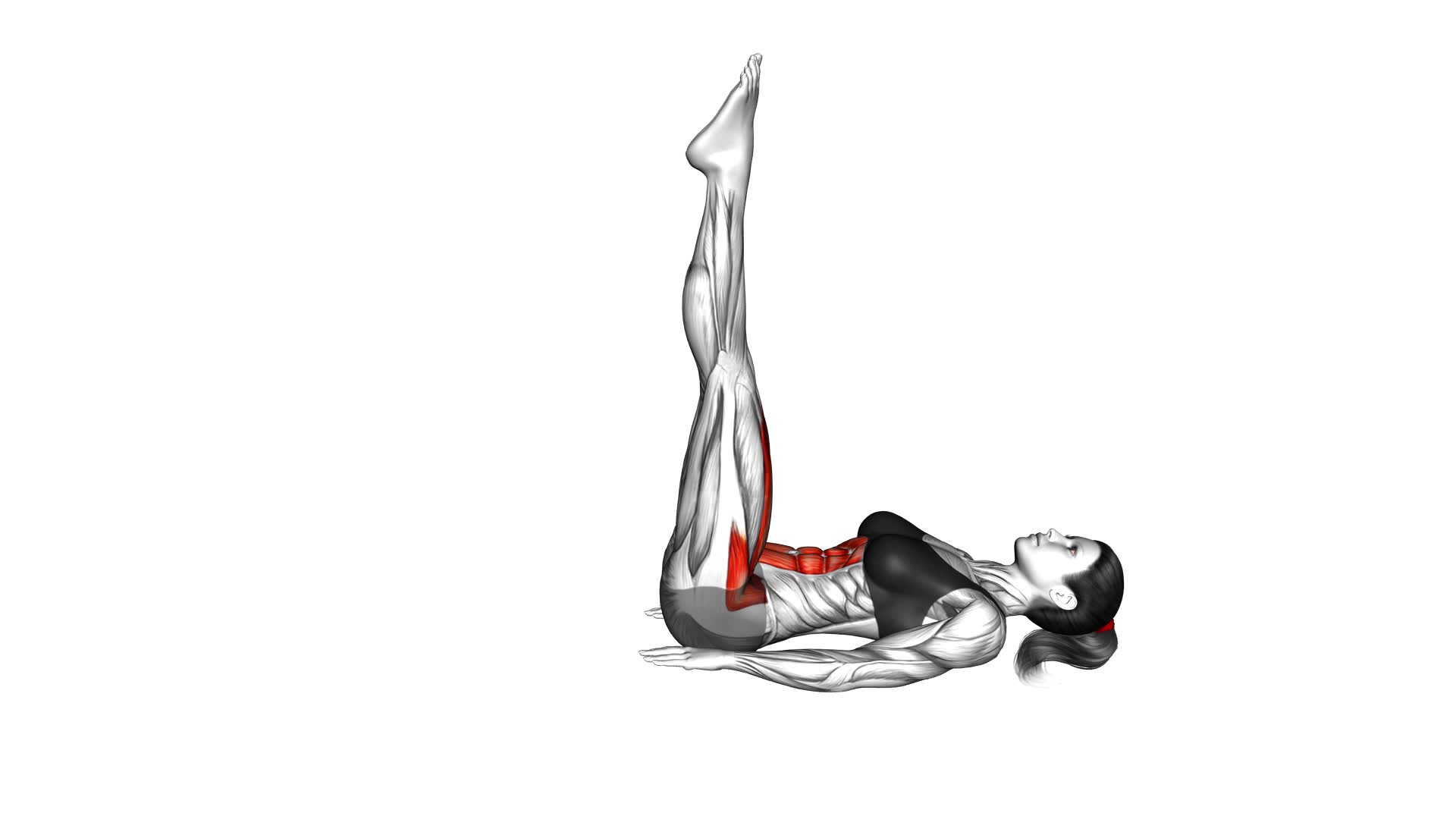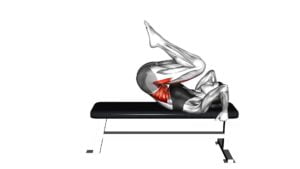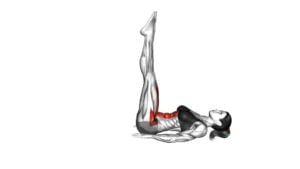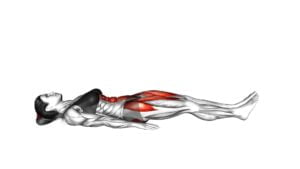Lying Leg Raise (female) – Video Exercise Guide & Tips

Are you looking for a challenging exercise to target your core and lower body? Look no further than the lying leg raise!
Watch This Exercise Video
In this video exercise guide, we'll show you how to properly perform the lying leg raise, along with variations and modifications to suit your fitness level.
Get ready to strengthen your abs, glutes, and thighs with this effective workout. Let's dive in and maximize your results with these helpful tips!
Key Takeaways
- Lying Leg Raise improves core strength.
- Lying Leg Raise tones lower abs.
- Lying Leg Raise enhances posture and stability.
- Lying Leg Raise targets rectus abdominis and obliques.
Benefits of Lying Leg Raise
You can experience several benefits from incorporating lying leg raises into your workout routine. This exercise is highly effective in improving core strength and toning your lower abs. By targeting these specific areas, lying leg raises can help you achieve a stronger and more defined midsection.
One of the primary benefits of lying leg raises is the improvement in core strength. As you lift your legs off the ground, your core muscles, including the rectus abdominis and obliques, are engaged to stabilize your body. This helps to strengthen your core muscles, leading to better posture and overall stability.
Additionally, lying leg raises are an excellent exercise for toning your lower abs. This exercise specifically targets the lower portion of the rectus abdominis, helping to tighten and tone this area. By consistently incorporating lying leg raises into your workout routine, you can achieve a more sculpted and defined lower abdominal region.
In order to reap the full benefits of lying leg raises, it's important to properly prepare for the exercise. This includes warming up your muscles, ensuring proper form, and starting with a weight that challenges you but allows you to maintain proper technique. By taking these steps, you can maximize the effectiveness of lying leg raises and achieve your fitness goals.
Now, let's move on to the next section and discuss how to prepare for this exercise.
Preparing for the Exercise
To properly prepare for the lying leg raise exercise, it's important to warm up your muscles to prevent injury and improve performance. Here are some warm-up exercises you can incorporate into your routine:
- Jogging in place or brisk walking for 5-10 minutes to increase blood flow and raise body temperature.
- Dynamic stretches such as leg swings, knee hugs, and ankle rotations to improve flexibility and range of motion.
In addition to warming up, it's crucial to be aware of common mistakes that can compromise your form during the lying leg raise exercise. Avoid these errors to maximize the effectiveness of the exercise and reduce the risk of injury:
- Using momentum to lift your legs instead of engaging your core muscles.
- Arching your back or lifting your hips off the ground, which can strain your lower back.
- Allowing your legs to drop too low, which can place unnecessary stress on your hip flexors.
Proper Form and Technique
To ensure proper form and technique during the lying leg raise exercise, focus on engaging your core muscles and maintaining a stable position throughout the movement. This exercise primarily targets the lower abdominal muscles and can be done with minimal equipment, making it a great addition to your at-home workout routine.
One common mistake people make when performing lying leg raises is using momentum to lift their legs instead of relying on their abdominal muscles. This not only reduces the effectiveness of the exercise but also puts unnecessary strain on the lower back. To avoid this, concentrate on using your core muscles to lift your legs in a controlled manner, keeping your movements slow and deliberate.
Another mistake is allowing the lower back to arch excessively during the exercise. This can lead to discomfort and potential injury. To maintain proper form, imagine pressing your lower back into the floor throughout the movement. Engaging your core muscles will help support your spine and prevent excessive arching.
In terms of equipment, a mat or a comfortable surface to lie on is all you need for this exercise. You can also use a stability ball or a bench to increase the challenge and engage additional muscles.
Variations and Modifications
What are some ways to modify or vary the lying leg raise exercise?
There are several variations and modifications you can try to make this exercise more challenging or suitable for your fitness level. Here are two options for variations and modifications:
- Bent Knee Variation:
- Instead of keeping your legs straight, bend your knees and bring them towards your chest.
- This variation reduces the resistance on your lower abdominal muscles, making it easier to perform the exercise.
- Weighted Leg Raise:
- To increase the intensity of the exercise, add ankle weights or hold a dumbbell between your feet.
- This modification adds resistance, challenging your lower abdominal muscles and making the exercise more effective.
Tips for Maximizing Results
Continuing from the previous subtopic, to maximize your results with the lying leg raise exercise, focus on maintaining proper form and technique throughout the movement. This is crucial in order to effectively target your abdominal muscles and avoid any potential injuries.
One key tip for maximizing intensity is to engage your core muscles throughout the exercise. By consciously contracting your abs, you'll intensify the workout and increase the effectiveness of the exercise.
Additionally, it's important to avoid common mistakes that can hinder your progress. Firstly, make sure to keep your lower back pressed firmly against the floor throughout the movement. This will prevent any unnecessary strain on your back and ensure that your abs are doing the work.
Secondly, avoid using momentum to lift your legs. This means controlling the movement and lifting your legs using only your abdominal muscles.
Lastly, remember to breathe properly throughout the exercise. Inhale as you lower your legs and exhale as you lift them up.
Frequently Asked Questions
How Many Calories Can Be Burned by Doing the Lying Leg Raise Exercise?
You can burn calories and activate your muscles by doing the lying leg raise exercise. This exercise targets your lower abdominal muscles and hip flexors, helping to strengthen and tone them.
While the exact number of calories burned will vary depending on factors such as weight and intensity, the lying leg raise is an effective exercise for engaging your core and promoting calorie burn.
Incorporate this exercise into your workout routine for optimal results.
Can Lying Leg Raise Exercise Help in Reducing Belly Fat?
Yes, the lying leg raise exercise can help in reducing belly fat. By targeting the lower abdominal muscles, this exercise can strengthen and tone your core, leading to a more defined stomach.
Additionally, incorporating lying leg raise alternatives, such as hanging leg raises or captain's chair leg raises, can provide variety and challenge to your workout routine.
The benefits of lying leg raise include improved posture, increased hip flexibility, and a stronger lower back.
Are There Any Alternative Exercises That Target the Same Muscles as the Lying Leg Raise?
If you're looking for alternative exercises that target the same muscles as the lying leg raise, there are a few options you can try.
Leg lifts, hanging leg raises, and reverse crunches all work the same muscles and can be effective alternatives.
These exercises engage your abdominal muscles and help strengthen your core.
Incorporating these alternative exercises into your routine can provide variety and help you achieve your fitness goals.
Can Lying Leg Raise Exercise Help in Improving Flexibility?
The lying leg raise exercise can be beneficial for improving flexibility. By raising your legs while lying on your back, you engage your hip flexors and lower abdominal muscles. This movement helps to stretch these muscles and increase their range of motion.
Additionally, there are variations of the lying leg raise that can further enhance flexibility, such as the hanging leg raise or the decline leg raise. Incorporating these exercises into your routine can help you achieve greater flexibility in your lower body.
How Long Does It Usually Take to See Noticeable Results From Doing Lying Leg Raises Regularly?
To see noticeable results from doing lying leg raises regularly, the optimal frequency is around three to four times a week. However, the time it takes to see results can vary depending on several factors.
Factors such as your current fitness level, diet, consistency, and genetics can affect the timeline. It's important to stay dedicated and patient.
With regular practice and a healthy lifestyle, you can start seeing improvements in your strength and muscle tone within a few weeks to a couple of months.
Conclusion
In conclusion, the lying leg raise is a highly effective exercise for strengthening and toning the muscles in the lower body, particularly the abs, hips, and thighs. By following proper form and technique, and incorporating variations and modifications, you can maximize your results and achieve your fitness goals.
Remember to listen to your body and start with a level that's comfortable for you, gradually increasing intensity as you progress.
Keep up the great work!

Author
Years ago, the spark of my life’s passion ignited in my mind the moment I stepped into the local gym for the first time. The inaugural bead of perspiration, the initial endeavor, the very first surge of endorphins, and a sense of pride that washed over me post-workout marked the beginning of my deep-seated interest in strength sports, fitness, and sports nutrition. This very curiosity blossomed rapidly into a profound fascination, propelling me to earn a Master’s degree in Physical Education from the Academy of Physical Education in Krakow, followed by a Sports Manager diploma from the Jagiellonian University. My journey of growth led me to gain more specialized qualifications, such as being a certified personal trainer with a focus on sports dietetics, a lifeguard, and an instructor for wellness and corrective gymnastics. Theoretical knowledge paired seamlessly with practical experience, reinforcing my belief that the transformation of individuals under my guidance was also a reflection of my personal growth. This belief holds true even today. Each day, I strive to push the boundaries and explore new realms. These realms gently elevate me to greater heights. The unique combination of passion for my field and the continuous quest for growth fuels my drive to break new ground.







